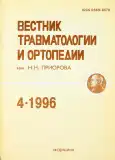Basis for Improved Osteosynthesis in Supraisthmic Tibia Fractures Using Pivots with Rectangular Transverse Section
- Authors: Kluchevskiy V.V.1, Litvinov I.I.1, Dzhurko A.D.1
-
Affiliations:
- Yaroslavl State Medical Academy
- Issue: Vol 3, No 4 (1996)
- Pages: 33-35
- Section: Articles
- URL: https://journals.rcsi.science/0869-8678/article/view/103937
- DOI: https://doi.org/10.17816/vto103937
- ID: 103937
Cite item
Full Text
Abstract
On the base of anatomic study of 300 cross-sections from 30 tibias the author conclude that in suproisthmic tibia fractures the pivot should be inserted into the nondrilled canal of bone fragments. Besides the pivot should be located more medially than tuberosity of the tibia and along the axis of the canal in isthmic region. To prevent the pivot wedging and fragments splitting the plane of wide sides of the pivot should be combined with the plane which is parallel to the medial side of the tibia independently on the fracture level. Modified pivot is suggested. Its proximal end has an additional crook towards the narrow sides. Pivot was applied in 18 patients and excellent results by Shvarzberg system score were achieved.
Full Text
##article.viewOnOriginalSite##About the authors
V. V. Kluchevskiy
Yaroslavl State Medical Academy
Author for correspondence.
Email: info@eco-vector.com
Russian Federation, Yaroslavl
I. I. Litvinov
Yaroslavl State Medical Academy
Email: info@eco-vector.com
Russian Federation, Yaroslavl
A. D. Dzhurko
Yaroslavl State Medical Academy
Email: info@eco-vector.com
Russian Federation, Yaroslavl
References
Supplementary files












